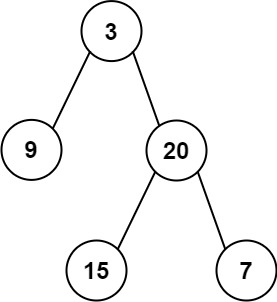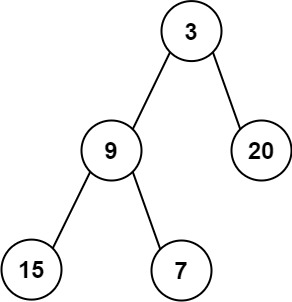- {x}
- K Inverse Pairs Array
- Course Schedule III
- Design Excel Sum Formula
- Smallest Range Covering Elements from K Lists
- Sum of Square Numbers
- Find the Derangement of An Array
- Design Log Storage System
- Exclusive Time of Functions
- Average of Levels in Binary Tree
- Shopping Offers
- Decode Ways II
- Solve the Equation
- Design Circular Deque
- Design Search Autocomplete System
- Maximum Average Subarray I
- Maximum Average Subarray II
- Set Mismatch
- Read More...

Average of Levels in Binary Tree
root of a binary tree, return the average value of the nodes on each level in the form of an array. Answers within 10-5 of the actual answer will be accepted.
Example 1:

Input: root = [3,9,20,null,null,15,7] Output: [3.00000,14.50000,11.00000] Explanation: The average value of nodes on level 0 is 3, on level 1 is 14.5, and on level 2 is 11. Hence return [3, 14.5, 11].
Example 2:

Input: root = [3,9,20,15,7] Output: [3.00000,14.50000,11.00000]
Constraints:
- The number of nodes in the tree is in the range
[1, 104]. -231 <= Node.val <= 231 - 1
Solution Explanation for Average of Levels in Binary Tree
This problem asks to calculate the average value of nodes at each level of a binary tree. Two common approaches are Breadth-First Search (BFS) and Depth-First Search (DFS).
Approach 1: Breadth-First Search (BFS)
BFS is well-suited for level-order traversal. We use a queue to process nodes level by level.
Algorithm:
-
Initialization: Create a queue
qand add the root node. Initialize an empty listansto store the average of each level. -
Level Processing: While the queue is not empty:
- Get the current level's size
n. This represents the number of nodes at the current level. - Initialize
s(sum) to 0. - Process
nnodes:- Dequeue a node from
q. - Add the node's value to
s. - Enqueue the node's left and right children (if they exist).
- Dequeue a node from
- Calculate the average
s / nand append it toans.
- Get the current level's size
-
Return: Return
ans.
Time Complexity: O(N), where N is the number of nodes. Each node is visited and processed once. Space Complexity: O(W), where W is the maximum width (number of nodes) of the tree. In the worst case (a complete binary tree), W can be proportional to N.
Approach 2: Depth-First Search (DFS)
DFS can also solve this, but requires a slightly different approach. We track the sum and count for each level separately.
Algorithm:
-
Initialization: Create two lists,
s(sum) andcnt(count), both initially empty. -
Recursive DFS: Implement a recursive function
dfs(root, level):- Base Case: If
rootis null, return. - Level Check: If the current
levelis beyond the size ofsandcnt, append 0 to both lists to create a new entry for this level. - Update: Add
root.valtos[level]and incrementcnt[level]. - Recursion: Recursively call
dfsfor the left and right children, incrementing the level.
- Base Case: If
-
Average Calculation: After the DFS is complete, iterate through
sandcnt, calculating the averages[i] / cnt[i]for each level and storing it in the result list.
Time Complexity: O(N), where N is the number of nodes. Each node is visited once.
Space Complexity: O(H), where H is the height of the tree. This is due to the recursive call stack and the size of s and cnt which are proportional to the height of the tree. In the worst case (a skewed tree), H can be equal to N.
Code Examples (Python)
BFS:
from collections import deque
def averageOfLevels(root):
q = deque([root])
ans = []
while q:
level_size = len(q)
level_sum = 0
for _ in range(level_size):
node = q.popleft()
level_sum += node.val
if node.left:
q.append(node.left)
if node.right:
q.append(node.right)
ans.append(level_sum / level_size)
return ansDFS:
def averageOfLevels(root):
sums = []
counts = []
def dfs(node, level):
if not node:
return
if level >= len(sums):
sums.append(0)
counts.append(0)
sums[level] += node.val
counts[level] += 1
dfs(node.left, level + 1)
dfs(node.right, level + 1)
dfs(root, 0)
return [s / c for s, c in zip(sums, counts)]These examples demonstrate both approaches. The choice between BFS and DFS depends on factors like the specific tree structure and memory constraints. For most cases, BFS is generally preferred due to its better space complexity for balanced or nearly balanced trees.